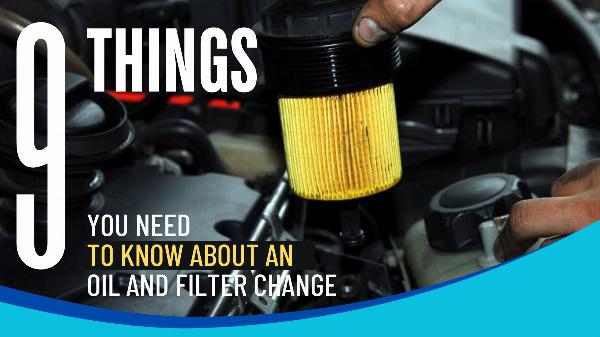9 Things You Need to Know About an Oil and Filter Change

Strong 8k brings an ultra-HD IPTV experience to your living room and your pocket.
Even with the advancement in car technologies today, to a major extent, there is still a requirement for manual intervention for the upkeep and maintenance of your vehicle.
Motor oil helps lubricate the different components of your vehicle. Modern vehicles have indicators that suggest your vehicle's oil levels, but most contemporary ones don't. In case of low oil or fluid levels, most vehicle's oil indicators start blinking when the oil levels in your vehicle are low.
It might feel a bit repetitive to keep checking your car's oil levels regularly, but it's a great way to check under the hood for fluid leaks to ensure there's no trouble.
Let’s delve into understanding a little more about oil and filter change.
1. Knowing when to change your motor oil
Motor oil needs to be changed when it gets old or worn out. Over time, it breaks down due to heat and pressure and can go bad. Even if your car sits parked for a while, the oil can still go bad.
If you want to know the exact recommendations, you can check the glove box. In the owner's manual, you will find all the tips and care needed to handle your car maintenance tips, including oil and filter maintenance. In the manual, you will also find ideal fluid and oil replacement times based on the distance travelled and the time of the last replacement.
2. Check the engine or oil change light
In the case of low oil, you can check for car warning signs in the car's indicator panel. In case the oil change indicator doesn't blink, it's a good idea to check the dipstick to check the accurate oil levels. This is your car's way of saying that things have gotten terrible and the engine could be in trouble because of broken parts or insufficient lubrication.
3. Let your car cool down after a long run before you inspect the oil levels.
If you've been driving your car in the long run, let it cool down for about 20-30 minutes before you check its oil levels and filter conditions. This is important to prevent the hot oil from burning you. Even though oil flows more easily when it's warm, it can cause serious burns in direct contact with the body. If you need to warm up the oil a bit before working on your car, you can run the engine for about 2 minutes. This will make the oil flow more easily but won't be hot enough to cause harm.
4. Use the right drain pan
You don't want the dispensed vehicle oil to spill everywhere, so you must use a drain pan. A drain pan ensures that your oil drains safely and securely. Some drain pans, like the funnel-top drain pan, completely cover the oil, reducing the risk of a messy spill. Some also have strong handles that make it easier to carry the dirty oil. However, having a drain pan (generally used in workshops) is not a must; you can use any vessel that will work as a drain pan.
5. Ensure you put oil in the engine and not over it.
For those new to changing oil, ensure that when you pour the oil, it goes into the engine and doesn't go over it. To do this, use a suitable funnel and pour the oil at the right angle. Always turn the spout on top over the funnel and pour slowly. This prevents air from entering the oil splash and bubble when pouring into the engine.
6. Dipstick is key
The dipstick is a crucial tool for maintaining your car and changing its oil. You can usually find it easily because it has a bright yellow ring. It shows you how much oil is in your engine.
Here's how to use it:
- Pull out the dipstick and wipe it with a rag.
- Put it back in, then pull it out again to check the oil level.
- Ensure to check the dipstick every time you add oil.
- After driving a few miles, check it again to see if there are any leaks.
- Keeping an eye on your dipstick helps you keep your car running smoothly.
7. Ensure your filters are tightly sealed.
Don't forget to seal your oil filter properly for a smooth oil change. A common mistake is putting it back on while it's still wet, which can cause leaks and loose fits.
Here's how to do it right:
Fill the filter halfway with oil.
- Spread a bit of oil around the filter for a good seal.
- This simple step can save you from a messy driveway and keep your car running smoothly.
8. Use protective gear/s
Staying safe and clean during an oil change is essential, especially if you're doing it at home. Before you start working on changing your car oil, ensure you have the right gear/s, like rubber gloves and clean towels, to keep oil off your skin and other surfaces. Also, put down a tarp or old shower curtain under your oil pan to catch any spills and protect your driveway.
9. Need a good grip while you change your vehicle's oil filters?
It's always good to keep the necessary tools handy when you plan to change your car's oil filters. Go to your nearby auto store, where you'll find many handy tools to make your oil change more accessible. It would help if you always looked for gripping tools designed to remove stubborn oil filters. You'll find different types, like clamp-style and 3-jaw adjustable wrenches, so you can choose the one that best fits your budget.
Why should you hire expert car mechanics for your vehicle’s oil and filter change?
Hiring professional car mechanics for your oil and filter replacement makes a lot of difference. They have the relevant experience and expertise to handle your vehicle.
Some of the main benefits of hiring a car mechanic for your oil and filter repair include:
- Use of industry-standard tools and techniques.
- Often if you are inexperienced, you may cause damage to your vehicle, which may lead to costly repairs.
- You may risk of voiding the manufacturer’s warranty, which will be taken care of by car mechanics.
- Car mechanics can ensure the use of genuine parts.
- Saves you time and energy
- Quality solutions
- They offer a warranty on workmanship and your replaced car parts
- Helps maintain your car’s resale value
And more
For more information about your oil and filter change for your Ford Ranger or any other vehicle, contact your nearest Ford mechanic. With industry-standard tools, techniques and relevant knowledge, professionals will quickly resolve your oil and filter change issue.
Note: IndiBlogHub features both user-submitted and editorial content. We do not verify third-party contributions. Read our Disclaimer and Privacy Policyfor details.


